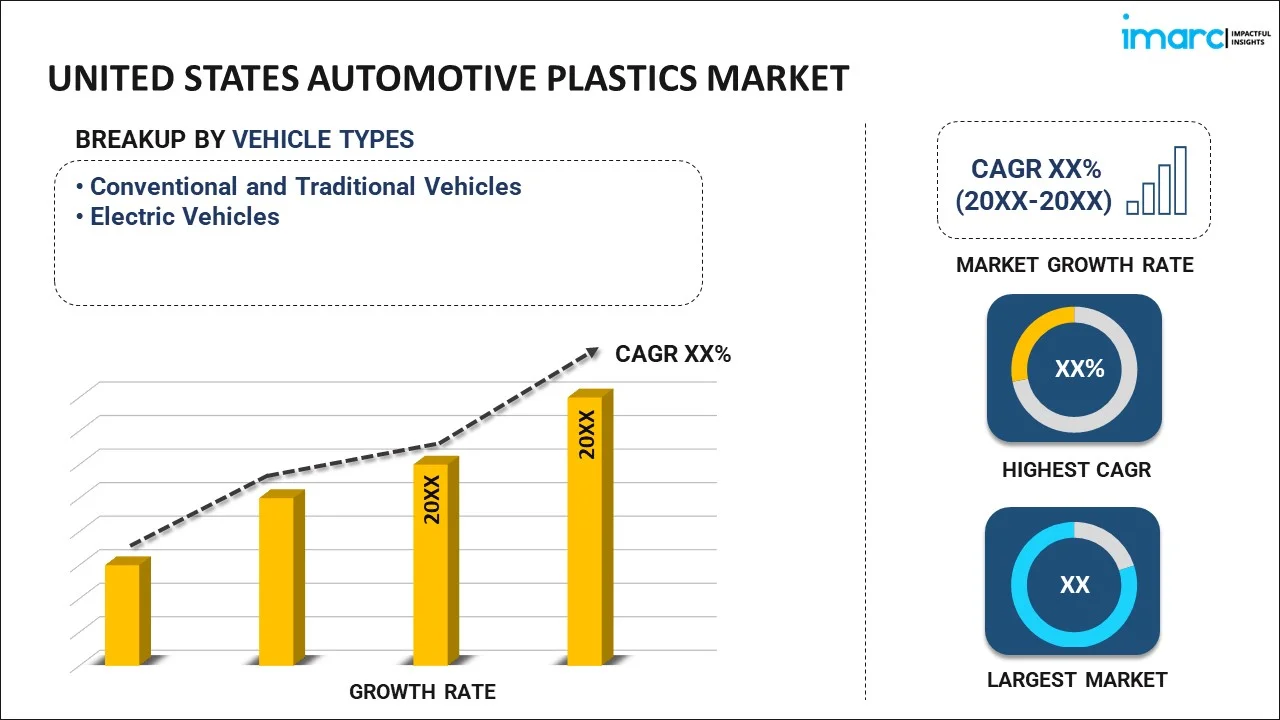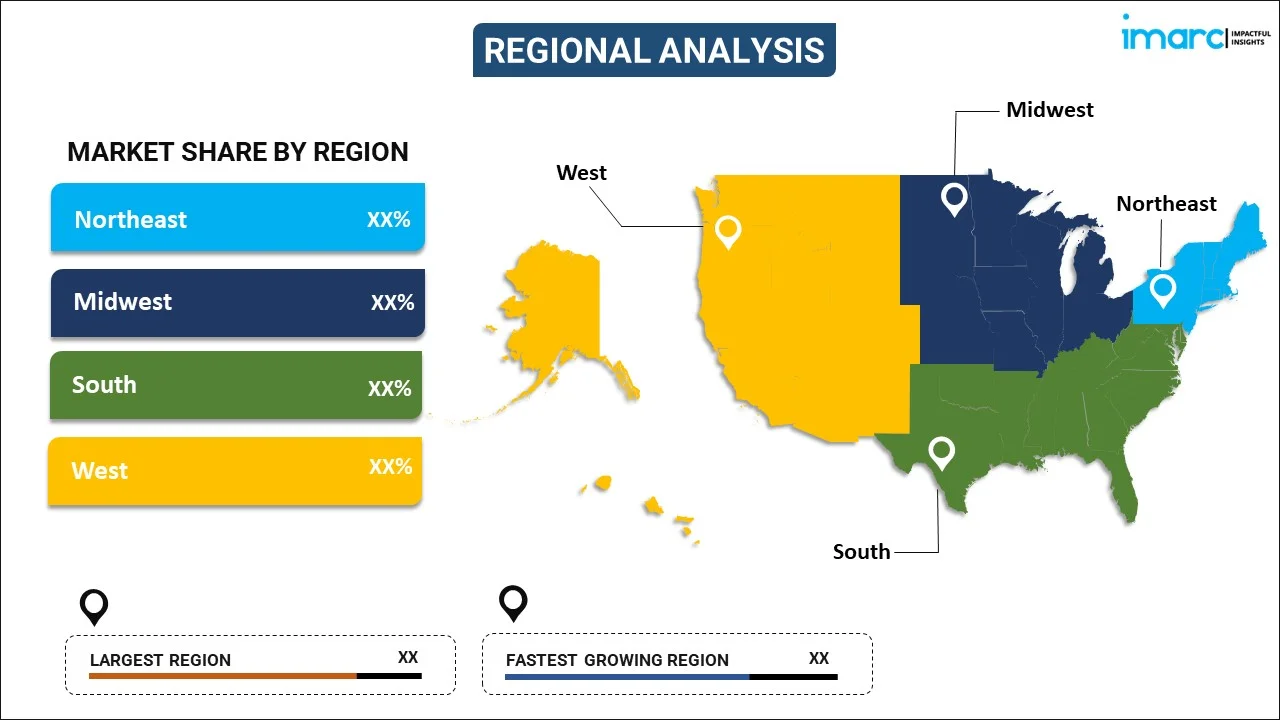
United States Automotive Plastics Market Report by Vehicle Type (Conventional and Traditional Vehicles, Electric Vehicles), Material (Polyethylene (PE), Polypropylene (PP), Polyvinyl Chloride (PVC), Acrylonitrile Butadiene Styrene (ABS), Polyurethane (PU), Polymethyl Methacrylate (PMMA), Polycarbonate (PC), Polyamide, and Others), Application (Powertrain, Electrical Components, Interior Furnishings, Exterior Furnishings, Under the Hood, Chassis), and Region 2025-2033
Market Overview:
United States automotive plastics market size is projected to exhibit a growth rate (CAGR) of 10.55% during 2025-2033. The escalating demand for lightweight and the growing usage of bio-based polymers by leading players to reduce their carbon footprint and promote sustainability represent some of the key factors driving the market growth across the country.
|
Report Attribute
|
Key Statistics
|
|---|---|
|
Base Year
|
2024
|
|
Forecast Years
|
2025-2033
|
|
Historical Years
|
2019-2024
|
| Market Growth Rate 2025-2033 | 10.55% |
United States Automotive Plastics Market Analysis:
- Key Market Drivers: The primary drivers of the market are growing vehicle production, higher demand for lightweight materials to enhance fuel efficiency, and more stringent environment regulations. Companies are also implementing high-performance plastics in interior, exterior, and engine parts to increase strength, safety, and overall vehicle efficiency.
- Key Market Trends: The industry is experiencing a move toward recycling plastics, bio-based polymers, and advanced composites. Adoption of new materials and manufacturing processes, including 3D printing, is allowing more intricate designs, greater functionality, and lighter weight, mirroring an overall trend towards sustainability and efficiency throughout vehicle production.
- Competitive Landscape: Firms are investing in research and development (R&D), partnerships, and localized manufacturing to consolidate their positions. There is serious investment in new material solutions, cost saving, and leading technologies that enable manufacturers to provide differentiated products while countering increasing demand for high-quality, lightweight, and robust automotive components.
- Challenges and Opportunities: Fluctuating raw material costs, compliance with regulations, and complexity associated with recycling are challenges. But the growing popularity of electric vehicles, lightweight materials, and green polymers presents opportunities. These can be used by companies to enhance vehicle efficiency, minimize environmental footprint, and address changing industry and consumer needs.
Automotive plastics encompass a variety of materials, including polypropylene (PP), polyurethane (PU), polyvinyl chloride (PVC), acrylonitrile butadiene styrene (ABS), nylon, polyethylene (PE), polyoxymethylene (POM), and polycarbonate (PC). These polymers play a crucial role in enhancing the durability of automobiles, providing greater design versatility, lowering production expenses, and facilitating the integration of components. Additionally, automotive plastics contribute to the reduction of vehicle weight by substituting heavier materials like metal and glass. This not only aids in energy conservation but also enhances fuel efficiency. In essence, the use of automotive plastics represents a multifaceted approach, positively impacting various aspects of automotive design, manufacturing, and performance.
United States Automotive Plastics Market Trends:
Increasing Use of Lightweight Materials
The United States automotive plastics market growth is being led more and more by the need for vehicles to use lightweight materials. Companies are substituting conventional metals with high-performance plastics and polymer composites for body panels, bumpers, interiors, and engine parts to decrease vehicle weight and increase fuel economy. Plastics with reduced weight assist in lowering emissions, better handling, and superior overall performance, both of which are in line with environmental standards. High-performance polymer formulations offer improved heat resistance, impact strength, and lifespan, allowing designers to realise both functional and visual objectives. Weight reduction is especially important for passenger cars and SUVs, where performance and efficiency are the deciding points of sale. This increased demand for light components will further dominate the industry, driving innovation in material science and ensuring plastics remain at the heart of contemporary automotive design.
Adoption of Sustainable and Recycled Polymers
Sustainability is becoming a key concern in the United States automotive plastics market analysis. Companies are using recycled and bio-based plastics more to build dashboards, interior trims, and panels, minimizing reliance on virgin materials and aiding regulatory compliance. Advanced processing methods now enable recycled polymers to achieve performance criteria for strength, durability, and appearance, enabling them to be used for structural as well as architectural purposes. The move towards circular economy-based sustainable plastics also helps reduce waste without compromising product quality. This uptake improves vehicles' environmental credential and mirrors consumer preference for sustainable design. With time, sustainable polymers will have an impact on material selection in various vehicle segments, inspiring manufacturing process innovation and bringing environmental thinking into mainstream automotive production.
Growth of Advanced Manufacturing and 3D Printing
The United States automotive plastics market size is being shaped by the widespread adoption of advanced manufacturing technologies like 3D printing and precision injection molding. These techniques support quick prototyping, customization, and production of intricately complex geometries that were unattainable using conventional manufacturing. Additive manufacturing minimizes material waste, reduces development cycles, and facilitates cost-effective low-volume production. Precision molding provides repeatable quality, durability, and finish for interior and exterior plastic components. The combination of these technologies supports new, light, and functional designs that address current automotive demands. Since producers will increasingly incorporate advanced production methods, the entire market size for motor vehicle plastics will keep amplifying, mirroring boosting demand for high-performance, long-lasting, and look-wise advanced parts, propelling the United States automotive plastics market share.
United States Automotive Plastics Market Segmentation:
IMARC Group provides an analysis of the key trends in each segment of the market, along with forecasts at the country level for 2025-2033. Our report has categorized the market based on vehicle type, material, and application.
Vehicle Type Insights:

To get more information on this market, Request Sample
- Conventional and Traditional Vehicles
- Electric Vehicles
The report has provided a detailed breakup and analysis of the market based on the vehicle type. This includes conventional and traditional vehicles and electric vehicles.
Material Insights:
- Polyethylene (PE)
- Polypropylene (PP)
- Polyvinyl Chloride (PVC)
- Acrylonitrile Butadiene Styrene (ABS)
- Polyurethane (PU)
- Polymethyl Methacrylate (PMMA)
- Polycarbonate (PC)
- Polyamide
- Others
A detailed breakup and analysis of the market based on the material have also been provided in the report. This includes polyethylene (PE), polypropylene (PP), polyvinyl chloride (PVC), acrylonitrile butadiene styrene (ABS), polyurethane (PU), polymethyl methacrylate (PMMA), polycarbonate (PC), polyamide, and others.
Application Insights:
- Powertrain
- Electrical Components
- Interior Furnishings
- Exterior Furnishings
- Under the Hood
- Chassis
The report has provided a detailed breakup and analysis of the market based on the application. This includes powertrain, electrical components, interior furnishings, exterior furnishings, under the hood, and chassis.
Regional Insights:

- Northeast
- Midwest
- South
- West
The report has also provided a comprehensive analysis of all the major regional markets, which include Northeast, Midwest, South, and West.
Competitive Landscape:
The market research report has also provided a comprehensive analysis of the competitive landscape. Competitive analysis such as market structure, key player positioning, top winning strategies, competitive dashboard, and company evaluation quadrant has been covered in the report. Also, detailed profiles of all major companies have been provided.
Latest News and Developments:
- In July 2024, LyondellBasell introduced its Schulamid ET100 grade, expanding its portfolio of engineered plastics for automotive interior applications. Designated for use in door window frames, among other applications, this lightweight, tough polyamide compound is aimed at increasing U.S. automotive plastics market growth as it addresses increasing sustainability, high-performance requirements, and the demand for advanced materials in North American vehicles.
United States Automotive Plastics Market Report Coverage:
| Report Features | Details |
|---|---|
| Base Year of the Analysis | 2024 |
| Historical Period | 2019-2024 |
| Forecast Period | 2025-2033 |
| Units | Billion USD |
| Scope of the Report | Exploration of Historical and Forecast Trends, Industry Catalysts and Challenges, Segment-Wise Historical and Predictive Market Assessment:
|
| Vehicle Types Covered | Conventional and Traditional Vehicles, Electric Vehicles |
| Materials Covered | Polyethylene (PE), Polypropylene (PP), Polyvinyl Chloride (PVC), Acrylonitrile Butadiene Styrene (ABS), Polyurethane (PU), Polymethyl Methacrylate (PMMA), Polycarbonate (PC), Polyamide, Others |
| Applications Covered | Powertrain, Electrical Components, Interior Furnishings, Exterior Furnishings, Under the Hood, Chassis |
| Regions Covered | Northeast, Midwest, South, West |
| Customization Scope | 10% Free Customization |
| Post-Sale Analyst Support | 10-12 Weeks |
| Delivery Format | PDF and Excel through Email (We can also provide the editable version of the report in PPT/Word format on special request) |
Key Questions Answered in This Report:
- How has the United States automotive plastics market performed so far and how will it perform in the coming years?
- What has been the impact of COVID-19 on the United States automotive plastics market?
- What is the breakup of the United States automotive plastics market on the basis of vehicle type?
- What is the breakup of the United States automotive plastics market on the basis of material?
- What is the breakup of the United States automotive plastics market on the basis of application?
- What are the various stages in the value chain of the United States automotive plastics market?
- What are the key driving factors and challenges in the United States automotive plastics?
- What is the structure of the United States automotive plastics market and who are the key players?
- What is the degree of competition in the United States automotive plastics market?
Key Benefits for Stakeholders:
- IMARC’s industry report offers a comprehensive quantitative analysis of various market segments, historical and current market trends, market forecasts, and dynamics of the United States automotive plastics market from 2019-2033.
- The research report provides the latest information on the market drivers, challenges, and opportunities in the United States automotive plastics market.
- Porter's five forces analysis assist stakeholders in assessing the impact of new entrants, competitive rivalry, supplier power, buyer power, and the threat of substitution. It helps stakeholders to analyze the level of competition within the United States automotive plastics industry and its attractiveness.
- Competitive landscape allows stakeholders to understand their competitive environment and provides an insight into the current positions of key players in the market.
Need more help?
- Speak to our experienced analysts for insights on the current market scenarios.
- Include additional segments and countries to customize the report as per your requirement.
- Gain an unparalleled competitive advantage in your domain by understanding how to utilize the report and positively impacting your operations and revenue.
- For further assistance, please connect with our analysts.
 Request Customization
Request Customization
 Speak to an Analyst
Speak to an Analyst
 Request Brochure
Request Brochure
 Inquire Before Buying
Inquire Before Buying




.webp)




.webp)












